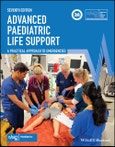A PRACTICAL APPROACH TO EMERGENCIES
The gold standard for treating paediatric emergencies
Advanced Paediatric Life Support: A Practical Approach to Emergencies is the internationally renowned manual on emergency paediatric care. Written to support the course run by the Advanced Life Support Group, the book uses their structured approach: a tried and tested practical method of treating children during the crucial first few hours of a life-threatening illness or injury. Advanced Paediatric Life Support is used by doctors, nurses and allied health professionals dealing with emergencies in children. Its clear layout and straightforward style make it a highly practical tool both for training and in the event of an emergency.
In the seventh edition you will find descriptions of both common and uncommon paediatric emergencies which you may encounter in clinical practice, their causes, and how to best treat them during the first hours after presentation.
This book offers a thoroughly evidence-based approach to its subject, which includes: - The latest International Liaison Committee on Resuscitation (ILCOR) 2021 guidelines - A thorough introduction to the structured approach to paediatric emergencies, including important non-technical skills and communication - Comprehensive explorations of the seriously ill child, including airway and breathing, circulation, decreased consciousness, seizures and exposure - Practical discussions of the seriously injured child, including examinations of chest, abdominal, brain and spinal injuries - Evidence-based life support treatment and the practical application of the Advanced Paediatric Life Support structured management
Perfect for emergency care physicians, nurses and other allied health professionals, Advanced Paediatric Life Support: A Practical Approach to Emergencies will also benefit paediatric clinicians, doctors-in-training and anyone else with an interest in the team management and treatment of paediatric emergencies.
Table of Contents
Contributors to Seventh Edition vii
Foreword xi
Preface to First Edition xii
Preface to seventh edition xiii
Acknowledgements xv
Contact details and further information xix
Part 1: Introduction 1
1 Introduction and structured approach to paediatric emergencies 3
2 Getting it right: non- technical factors and communication 19
Part 2: The seriously ill child 29
3 Structured approach to the seriously ill child 31
4 Airway and Breathing 45
5 Circulation 65
6 Decreased conscious level (with or without seizures) 93
7 Exposure 115
Part 3: The seriously injured child 125
8 Structured approach to the seriously injured child 127
9 The child with chest injury 147
10 The child with abdominal injury 157
11 The child with traumatic brain injury 161
12 The child with injuries to the extremities or the spine 173
13 The burned or scalded child 183
14 The child with an electrical injury 191
15 Special considerations 195
Part 4: Life support 207
16 Basic life support 209
17 Support of the airway and ventilation 227
18 Management of cardiac arrest 245
Part 5: Practical application of APLS 259
19 Practical procedures: airway and breathing 261
20 Practical procedures: circulation 277
21 Practical procedures: trauma 295
22 Imaging in trauma 309
23 Structured approach to stabilisation and transfer 323
Part 6: Appendices 337
Appendix A Acid-base balance and blood gas interpretation 339
Appendix B Fluid and electrolyte management 357
Appendix C Paediatric major trauma 371
Appendix D Safeguarding 375
Appendix E Advance decisions and end of life 383
Appendix F General approach to poisoning and envenomation 397
Appendix G Resuscitation of the baby at birth 419
Appendix H Drowning 439
Appendix I Point of care ultrasound 445
Appendix J Formulary 455
List of algorithms 477
Working group for seventh edition 479
References and further reading 481
Index 487
How to use your textbook 508








